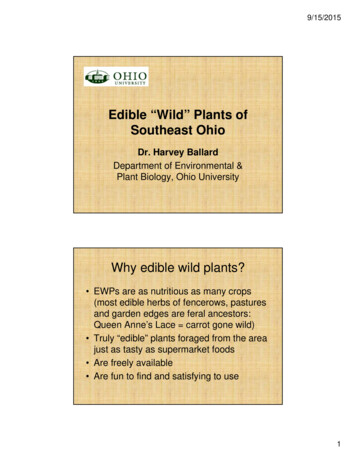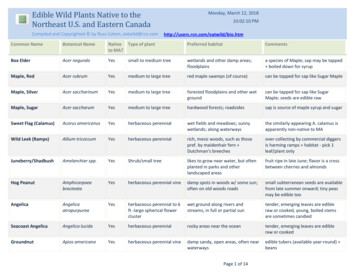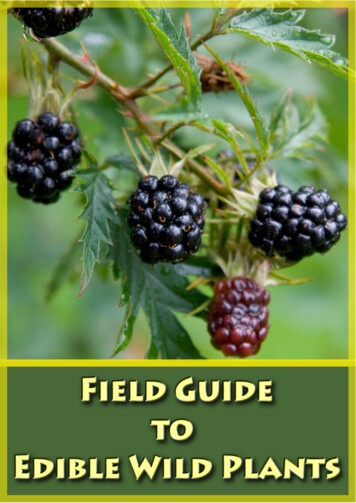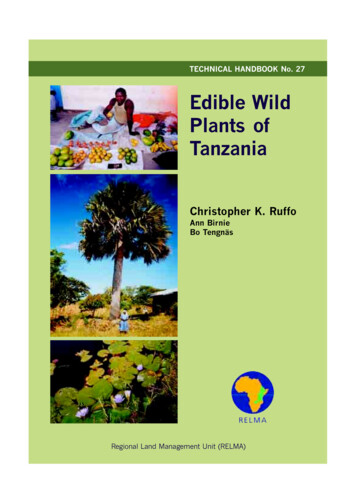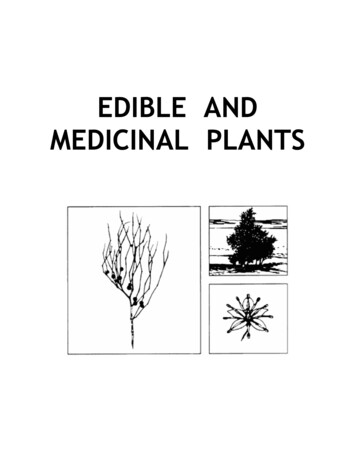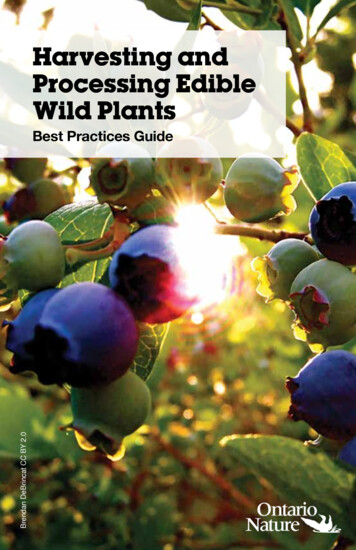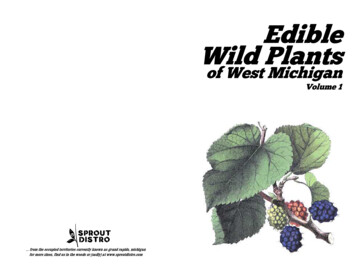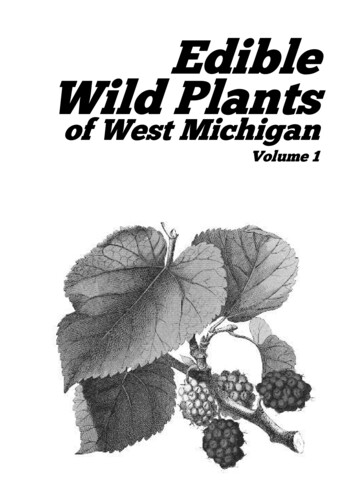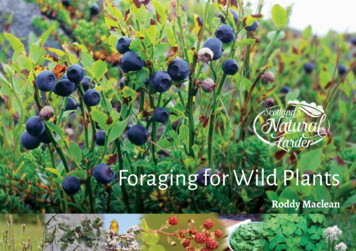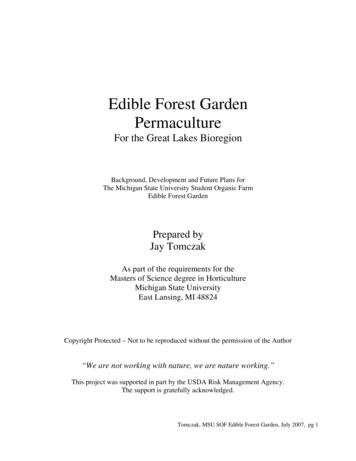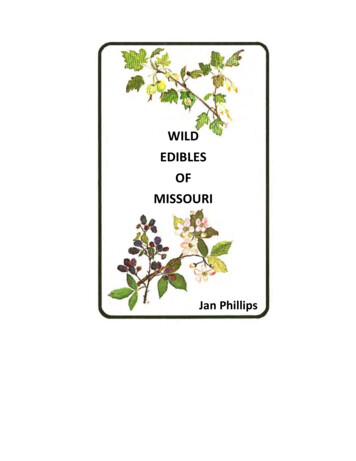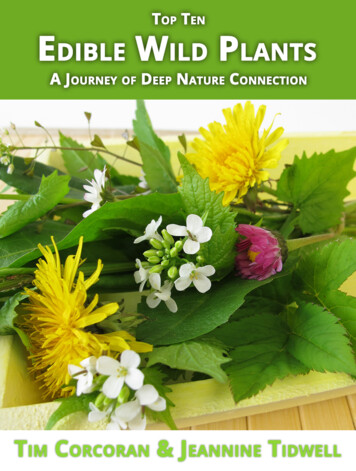
Transcription
Top Ten Edible Wild PlantsA Journey of Deep Nature ConnectionThis book is dedicated to the plant wisdom of our indigenous ancestors, those whowere the caretakers of our Earth in honor of the future generations.First EditioneBook 2014 Twin Eagles Wilderness SchoolAll Rights Reserved.By reading this guide, you agree Twin Eagles Wilderness School, Tim Corcoran,and Jeannine Tidwell are not responsible for any use or misuse of the informationcontained within this guide. This content is provided for informational purposesand is not meant to substitute for the advice provided by your physician or othermedical professional. You should not use this information for diagnosing ortreating a health problem, disease or injury, or prescribing any medication. If youhave or suspect that you have a health problem, serious or otherwise, promptlycontact your health care provider. Information and statements regarding plantshave not been evaluated by the Food and Drug Administration and are notintended to diagnose, treat, cure, or prevent any disease. You agree to work withplants responsibly and safely for yourself and others.
Table of ContentsWhy Learn Edible Wild Plants? . 3How to Use this Guide . 6An Edible Wild Plant Primer . 10Dandelion . 16Broad-leaf Plantain . 20Cattail . 24Stinging Nettle . 28Chickweed. 32Red Clover . 37Spearmint . 41Common Burdock . 44Wild Strawberry . 49Wild Ginger . 52Conclusion . 562
Why Learn Edible Wild Plants?Edible wild plants present a powerful opportunity to all of us living in the modernworld to live a richer, more connected life. By taking the journey of eating wildplants, we’re able to experience a vibrant state of health in body, mind, heart, andspirit.We reconnect with our earth based ancestry, and step into partnership with natureonce again. We take a step into responsibility for our nutritional needs, rather thanlive in dependence of grocery stores,farms, roadways, telecommunication &power grids. We empower ourselves,our family, and community as wejourney back to the simple roots of whatit means to be a human being living onplanet Earth.In that way, we experience anNez Perce woman gathering Camas bulbsarchetypal connection of what it meansto be a provider that brings with it anunspeakably deep sense of belonging, meaning, and purpose to our lives. Westep closer to our original birthright, becoming fully human.That is why we wrote this eBook, because we’ve enjoyed this level of deepconnection for years, and it is our passion to share that with you! Whether it islearning to eat a dandelion greens salad for this first time, or going out on aweeklong wild edibles quest, our great hope is that you connect with the essenceof the wild plants, the Earth, community, family, and self.3
Learning edible wild plants will give you confidence and peace of mind in anemergency. Being able to provide wild food for yourself, your family, andcommunity is authentic security.Whether you’re learning edible wild plants to experience a superhuman state ofhealth, to connect deeply with nature, or for wilderness survival, this journey issure to bring you to a place of living life to the fullest!One of the reasons so many people love edible wild plants is that they're free. Thefact that you can get fresh food in season that has higher nutrient content thanstore bought foods for less or no cost is pretty wonderful.Store bought food has often been farmed using less than holistic practices, thenharvested before it is actually read to eat, then processed using dangerouselements and processes, and then packaged and sat on a shelf for a long timebefore you get to it.Eating wild plants means seeing your foodin its natural environment, buildingrelationships with the plants, ethicallyharvesting, minimal & holistic processing (ifany), and eating fresh. The full range ofnutrients, vitamins, and minerals arepresent in the wild foods, and the tastes ofwild edible food is more complex anddelicious. The qualities of wild edible plantsalso stimulate digestive juices that causeWild Edible Saladyou to assimilate the food more easily.4
Building this kind of relationship to nature lends itself organically to connectingdeeply with family and friends. Some of our most treasured moments ofconnection have happened while harvesting cattail roots and picking nettle leaves.The experience of wild edibles connects you to nature in a very powerful way. Itasks you to slow down from the rushed pace of the modern world and step intotimelessness. Developing relationships with wild edible plants will bring greatermeaning to your life, and greater health to your body, mind, heart and spirit. Thatis good medicine that we all need!5
How to Use this GuideRather than looking at this as just another eBook, consider it a mentor. Theinformation, and more importantly the processes, that we suggest here will guideyou on a deep journey of connection. Take your time as you read through thisguide, and allow it to inspire you into action. We’re going for a change in practiceshere, which will result in new outcomes in your life.Always consider the big picture as you learn plants. Approach them as you woulda wild animal – carefully and cautiously with awareness. Where are they growing?What is their natural cycle? Can you envision them growing from seed to stalk toleaves to flower to fruit and back to seed? How do they relate to the rest of thenatural world? Are they common or rare?How might picking them impact not just thatparticular species, but the ecologicalcommunity that they are a part of? Take onthe mindset of the caretaker, almost like agardener of the wild, so that your actionscause these flowering friends to flourish forPonderosa Pine forest w/ Arrowleaf Balsamrootfuture generations.There have been more than a few times when we’ve been very excited to discovera new wild edible plant, but decided not to harvest it because it wasn’t growing inenough abundance to warrant being harvested.Most of all, get outside and start experiencing these edible wild plants!The learning is in the doing.6
Our SecretMost guides out there will just start you off learning plants in a fairly isolatedmanner. Sure, you might acquire basic knowledge, but the deeper connectionsare often missed entirely.If you really want an advantage, and a deeper connection, adopt one place innature that you return to in all times of day, in all kinds of weather, in all thedifferent seasons. Go to this place regularly, at least three times a week for atleast 30 minutes at a time, and just observe.We call this a “Sit Spot” or “Secret Spot”.Open your senses and lose your mind.Really. Quiet your mind and actually bepresent to the natural world. Notice theplants, and how they respond to differentweather/times of day/times of year.Here is where you really begin to build adeep relationship with the plants, andThe Sit Spotexperience them for what they are – richly interconnected with all of life. An initialgoal is to truly learn one plant deeply, that is build an intimate relationship with it.That depth of connection will be transferable to other plants as your journeycontinues.Over time, you’ll learn – and more importantly deeply connect – with the plants ofthis place. As you combine this deep connection with practically applied speciesknowledge, you’ll develop an intuitive ability to determine how much and when toharvest, in the way of a caretaker. As time progresses, your relationship with yoursit spot will flourish, and you’ll likely experience it as a treasured friend.7
A good sit spot will be convenient, that is you can get to it easily enough that youwon’t later use the distance as a reason for not going. Natural edges – wherewater meets land, where forest meets field, etc. are always more diverse, andmake great sit spots.Remember, the most important thing is to go to your sit spot! Do what you need toin order to make it work.Processing the ExperienceAs you learn and build lasting relationships to the edible wild plants, take the timeto reflect and integrate your experience. Reflect on the following:What was my experience? What went well? What did I find challenging?What am I learning from this experience? About plants, myself, and nature?How is that like the rest of my life? What is the bigger life lesson here?This is where the gold is. Modern brain science and native wisdom agree that wehumans learn most through recapitulation – that is we learn most by activelylooking back at our experience.We encourage you to reflect deeply on these questions in a journal, or with afriend or family member. If you really want to succeed, make a commitment tosomeone as a plant partner. Go out and build relationships to the plants together,then come back and process your experience with one another. Some of ourgreatest times of learning have happened in such a context.Take the time to draw pictures of the plants you are learning. Not by copying fromwhat you’re looking at, but by using a process called mind’s eye journaling. Lookat the plant. Really look at it. Notice shapes, colors, shadow, edges, texture, light,8
and more. Close your eyes. Can you picture the plant, in every detail, as if youwere looking at it? Open your eyes and check. What did you get right? Whatdidn’t you notice? Keep doing this until you’ve got it all down.Then go and draw your picture from this mind’s eye image. This is one of themost deep and powerful ways of learning. This not only builds a very practicalmuscle of actually noticing more, but also supports our journey as visionaries andcreators of tomorrow’s solutions. Again, modern science and native wisdom agreethat this process of mind’s eye journaling is excellent training for creative leadersand visionaries.Our indigenous ancestors had the process of reflection and integration built intotribal life. Elders would hold space for the youth, as they asked them questionslike those written above. Thousands of years living close to the Earth taught themthe wisdom to ask artful questions from a place of care for the youngergenerations. They knew that by asking good questions, and then listening to thestories that the youth responded with, the youth’s journey of connection woulddeepen and they would come into authentically greater relationship with the plants,and all of the natural world.This would influence their future role as leader and caretakers. This was a majorcultural element of how our earth based ancestors functioned, and successfullymaintained a regenerative culture. We have much to learn here. At Twin EaglesWilderness School, we consciously integrate this and other cultural elements intonot just what we teach, but how we teach. We notice that our modern communitytends to flourish in this context. This is one way that we can model ourselves afterour earth based ancestors, and bring back the deep social ties that so many longfor.9
An Edible Wild Plant PrimerIn this section we offer some important big picture information to integrate beforeyou set off learning the top ten edible wild plants. Check it out:Hazard Alert – Poisonous Plants!There are wild plants out there deadlyenough to kill you. Did you know that ifingested, just a pea sized chunk of waterhemlock root can kill an adult human?Wow. Take your time here.We have intentionally chosen the specieson our top ten list in part because theyDeadly poisonous Water Hemlockdon’t have poisonous look-a-likes. That makes them that much safer.In the big scheme of things, poisonous plants are quite rare, relatively speaking.You’re more likely to get hurt from a car accident, so long as you take the time tolearn and respect the poisonous plants in your bioregion. There are probably justa handful that you need to know.We’ve designed this guide for beginners, so you can feel safe learning and eatingany of the wild edible plants on our top ten list. However as your learning journeyprogresses, be sure to learn the poisonous plants that are out there before goingmuch further with edible wild plants.Once you learn the poisonous plants, it makes learning edibles easy, becauseyou've already "weeded out" the poisonous ones. We highly recommend you getyour hands on Peterson's Field Guide to Venomous Animals and Poisonous10
Plants by Roger Caras and Steven Foster. This book will be your ally in identifyingpoisonous plants.How to Identify Wild EdiblesIt’s important to learn basic plant identification skills before gathering and eatinganything. There are many plant look-a-likes and you need to identify with 100%certainty the one you're looking for. While it’s true that most plants are notpoisonous enough to kill you, there are plenty that will make you sick if ingested inthe wrong way.You'll discover that it’s necessary to know which parts of the plants are actuallyedible, and that there are certain processing and cooking techniques needed tomake your wild plants safe to eat.People tend to overreact to hazards, so put what we’re saying in context here.Apple and cherry seeds are toxic to humans if ingested in enough quantity, and wehave just learned not to eat them, and now take that knowledge for granted.Some of the best ways to practice identifying edible wild plants is to learn theplants in their various phases of growth. You can do this by visiting your sit spotthroughout the seasons. This will give you a chance to observe the plants in theirdifferent stages. From there, journal the plants, using your mind’s eye, and usefield guides as a resource for learning.This guide will give you a good introduction to basic plant identification skills.Again, as you progress beyond the edible wild plants covered in this guide, weencourage you to deepen your plant identification skills. We recommend checkingout Newcomb's Wildflower Guide by Lawrence Newcomb. This book has a simplekey system that makes it very easy to identify plants.11
Harvesting Wild Edible Plants – How, When, and EthicsIt's important to have the proper outlook when gathering wild edible plants. Beinghonorable, sensitive, appreciative, and aware of the plants and animals that liveand breathe through the landscape every day is an essential part of thatperspective. When you gather from a plant, collect at most 5% of the plant standwhere you are. That way the plant can reproduce and maintain its integral role inthe larger ecosystem.Our earth based ancestors took the time to give thanks for the life of the wildedible plants. Imagine feeling their heartfelt gratitude of seeing the first burst ofchickweed leaves in early spring after a long hard winter. Life was literally beingrenewed in front of their very eyes. How could one experience such a thingwithout profound gratitude?Life is so full of stress and challenges. Spending time in nature, slowing down,and opening up our senses becomes good medicine for our all too often rushedlives. Experiencing the beauty, simplicity, power, and life essence of edible wildplants is inspiring! Authentic gratitude is a natural response, and sets the stage forethically harvesting edible wild plants. Of course we would want to conserve thesetreasures.When you gather plants in their appropriate stages, you create a beneficialsymbiotic relationship with you and the plant. You wouldn't want to gather the plantin the wrong phase of its life cycle because the plant is busy investing its lifeenergy in its other parts. For example, you wouldn't want to harvest roots in themiddle of the summer because all the energy in the plant is above ground, workinghard to grow the stalk and leaves.12
The general rule of thumb for gathering edible wild plants in season: Gather leaves in spring and summer Gather fruits in late summer and fall Gather seeds after flowering in late summer and fall Gather roots in late fall and winterWhen you gather, it's nice to have a container or basket, a tool for cutting theplants or a shovel for gathering roots. The methods are different for gathering eachplant and its parts simply because each plant is unique. Over time, you'll learn howto become more sensitive to the plant and more efficient with your time andenergy.For example, when harvesting burdockroots, you’ll quickly discover that the soiltype makes a huge impact on how easyor difficult they are to harvest. They willpop right out of soft muddy soil, but theywill hang on for dear life in hard and rockyground. As well, you’ll find that a diggingstick makes harvesting those roots muchFreshly harvested Common Burdock plantseasier.Processing Edible Wild PlantsSo you've gathered some amazing and beautiful wild edible plants; now it’s time toprocess them. If the plant needs washing, depending on what kind of plant it is,gently rinse the plant material in cool, clean water. For drying your bounty, thereare many ways of hanging, lying ,or drying such as using screens, paper bags,bundled bunches, or food dehydrators. It’s mostly berries that get frozen although13
you can freeze leaves as well. We have a variety of approaches and recipesincluded in this guide to help you get started.Tasting the Wild! Eating your HarvestSome plants can be appreciated when you combine them with others and someplants are wonderfully savored on their own. Some are solely edible while othersare also medicinal. During your research with this eBook and beyond, be sure toget to know the properties of the plant you’ll be working with.Consider taking a moment to presence gratitude once again for your harvest. Feelthe connection with the food you're eating and send your mind's eye back to thespot where it grew. Can you recall all the details of that special place? Can you stillsmell the aroma of that patch of woods? Can you feel the same feeling in yourbody as you did back there? This powerful connection includes you in the systemof giving and receiving, life and death.Some plants need cooking before eating and some don't. It's different for eachplant so here's where research comes into the picture. Once you've got a body ofexperience with wild edible plants, try to practice foraging and browsing on wildedibles directly in the field, like the other animals do. Again, using recipes forcooking edible plants is a great way to learn and experiment!14
The Top Ten List of Edible Wild PlantsOK, all set? With no further ado, we now present our top ten list of edible wildplants:1. Dandelion2. Broad-leaf Plantain3. Cattail4. Stinging Nettle5. Chickweed6. Red clover7. Spearmint8. Common Burdock9. Wild Strawberry10. Wild GingerIn the section below, each of these ten plants is expanded upon at length. Takeyour time as you learn about these plants, and put what you learn into practice!15
DandelionDandelion is a very common plant. Youcan find it almost anywhere. It’s aperennial plant which means it comesback year after year from the same root.You can’t mistake dandelion. It has beencalled the supermarket of the lawnbecause literally every part of the plant isedible. In the spring dandelion flowerheads are bursting with tiny yellow flowerpetals splashing lawns, fields and meadows everywhere.Field Marks Green toothed leaves growing from the base of the plant. Grows 2 – 18” tall. Yellow flowers packed with petals. Seed heads: Tiny brown seeds are embedded in an airy sphere of silveryfuzz, 1-2” wide.Poisonous Look-a-Likes None.Flowering and Fruiting Season Flowers spring and summer.16
Habitat Roadsides, woods, meadows, lawns, parks, in sidewalks. They love growing in low grass. Prefer moist soil and full sun.Range Throughout North America.How to Harvest Leaves: clip off leaves in the spring and summer. Flowers: pluck off flower heads in spring and summer. Roots: 1 – 2” around the leaves dig 6” or more straight down into the soil toloosen and pull roots out.How to Process Leaves: Rinse in cool water and pat dry. Flowers: Pull the yellow flower petals out from the small green leaves(sepals) surrounding them, then rinse in cool water and pat dry. Roots: Scrub well, peel if desired, rinse and let dry.How to Preserve Leaves, stems and flower petals can be frozen for later use in a containeror zip lock bag. Leaves and roots can be dried on screens. Store roots in an airtight container or glass jar for later use.17
Dandelion RecipesDandelion Salad Gather a hearty handful of small, young dandelion leaves. Wash and rinse.Add to salad and toss with salad dressing (our favorite is extra virgin oliveoil and balsamic vinegar). The slight bitter taste of dandelion leaves helpstimulate and activate digestive juices, thus strengthening your digestionoverall.Dandelion Root Coffee In the fall and early spring the dandelion roots are storing the highestamount vitamin A, C, iron and calcium. Thus, this is the best time to brewup a cup of dandelion coffee. With a garden spade or shovel dig downaround the leaves and loosen the soil. The dandelion roots should pull upfairly easily once the soil has been loosened. Once you’ve processed the roots (see above), roast in the oven at 125degrees (or your oven’s lowest setting) until roots are dry. Grind in a coffeegrinder. Steep 1 tsp. in one cup of boiling water. Steep for 20 minutes ormore. Let cool and drink by itself or add cream and sweetener if desired.You might just not drink regular coffee again after drinking this herbal elixir! Dandelion roots have many medicinal benefits as well. Dandelion root tea isgreat for kidney and bladder ailments because it helps to eliminate toxins.Dandelion also helps with weight loss, weak digestion and due to its highfiber content, it also helps with constipation. Dandelion has a lot of vitaminC in it which is good for the health of your liver. Try this drink even as an allaround tonic or blood purifier for cleansing.18
Dandelion FrittersIngredients 2 cups dandelion flowers, rinsed 1 ¼ cups flour 1 egg 1 cup milk of any kind Olive oil, canola oil or butterPreparation Combine flour, egg and milk and mix well. You can add a little more flour ifyou want your batter to be thicker. Heat olive oil in skillet. Dip dandelionflower heads into batter until completely covered and lay into skillet. Cookjust like pancakes to the brownness you like. Serve warm with dandelionblossom syrup or other syrup, honey or applesauce. Dining on dandelionfritters will re-awaken dreams of warm and balmy summer days when thewind blows the dandelion seeds up to the sky, inviting you to float withthem.Dandelion is a tremendously powerful plant. They are adaptable and courageousanchors holding the soil with their long and hardy roots. They disperse themselvesby their umbrella-like seeds, floating through the air through many kinds ofweather only to plant themselves in the soil and take root under just about anykind of condition. They’re like the networkers of the field and forest. Dandelionsare living legends in their own right.19
Broad-leaf PlantainLook down on lawns everywhere in thespring and summer and you’ll find theBroad-leaf plantain. Plantain leaves makea great addition to wild salads, and theirseeds are full of Vitamin E which is anatural mosquito repellant. When you’vegot a wasp or bee sting on your hands atthe height and in the heat of the seasonit’s plantain that will bring you immediate relief. Once you start searching aroundfor plantain it naturally becomes easy to find.Field Marks Long, oval and ribbed green leaves all growing from the base of the plant. 6 – 18” tall - tightly packed greenish-white flower head. Tiny indistinguishable flowers packed on a spiked body.Poisonous Look-a-Likes None.Flowering and Fruiting Season Late spring to early fall.20
Habitat Lawns, meadows, grasslands, roadsides and even disturbed areas. Prefer sunlight and moist soils though can survive in dry soils. Can be found growing near dandelion and/or clover.Range Throughout North America, except parts of far north.How to Harvest In the spring pluck young leaves from the base of the plant. In summer and fall, select the smaller, younger leaves for best results.How to Process Wash leaves and let dry.How to PreserveDry Lay out on a screen in full sun or a dehydrator for best results.Freeze Blanch leaves by plunging them into boiling water for just a few secondsand then follow with a quick dip in ice water for a few seconds. Dry them offand place in a container in the freezer for future soups, stews or stir fry. This process sets the color of the plant without actually cooking it all thewhile preserving the plant’s texture. Boil for 10 – 15 minutes when you thaw them for future use.21
Broad-leaf Plantain RecipesPlantain SeasoningIngredients ½ Tbsp. sesame oil ½ Tbsp. Braggs or soy sauce ½ garlic clove A handful of roasted plantain seedsPreparation Mix and let rest for 5 minutes. Enjoy sprinkled over rice, pasta or salad oranything you’d like to try it as a condiment on!Plantain Salad Gather the fresh young plantain leaves in the spring and early summer.Wash and dry. Add to your salad and toss with salad dressing. It’s thatsimple!Plantain Poultice One of the simplest ways of letting plants heal wounds and injuries isthrough making a poultice. Just chew up the leaf well and put it on thewound, then cover with a Band-Aid to keep the plant matter in place overthe wound. Saliva and the moisture in your mouth contain many antibacterial properties.22
I (Jeannine) once took a walk in the woods with a group of children I was leadingat one of our summer camps. A young girl, Marina, suddenly got stung by a yellowjacket that had emerged from a log she had stepped over. I described plantain tothe kids and lo and behold another child, Anna, wandered off and found a bunchswiftly.I had Marina chew it up and place the leaf poultice directly on the sting area andsure enough she calmed down immediately. The medicine acted quickly. We thensat for a while and shared with each other the amazing relationship that plantainhas with wasps and bees and the dependency that humans have with plantain asa result of something like a wasp or bee sting. What started off as a challengingsituation turned out to be a moment of deep connection for all of us!23
CattailCattail has been affectionately called thesupermarket of the swamp. It is a veryimportant and common wild food, with avariety of uses at different times of year.Beyond its edible qualities, it has variousmedicinal and utilitarian uses as well.Field Marks Green spike in spring leading to a brown spiked flower by the end ofsummer and a fluffy brown seed head in the fall, up to 27” long. Long green sheath-like leaves growing up to 10 feet long. Stands up to 10 feet tall.Poisonous Look-a-Likes None.Flowering and Fruiting Season Late spring all through summer.Habitat Prefers open direct sunlight. Loves to grow in wet, damp soils, swamps and water.Range Throughout North America.24
How to Harvest To gather early shoots: In springtime, find the base of the plant and look forthe young green leaves poking out from the center. Harvest the shoots thathave not started flowering at the top yet. While mucilaginous and sticky,with a good grip to the inner core they should pull right out with a good tugto them. To gather cattail pollen: In summertime, bend the flower head at an angleand put a paper bag over it. Lightly shaking will release the pollen into yoursack. It helps if you gather on a non-windy day. You could also try dustingthe pollen into your hands. See what works right for you. To gather roots: get a shovel and dig last year’s roots in the springtime. Youneed to dig down quite deep as they are firmly planted deep in the mud andother kinds of soil. You’ll get a good work out from digging up cattail rootsbut keep working at it and they’ll come up.How to Process Shoots: Once you rinse them off well and peel them, they are ready to eatas is like cucumber or asparagus. You can also add them to soups, saladsor stir fry. There’s a lot of Vitamin C and other vitamins and minerals inthese shoots. Roots: After washing them, you’ll either need to peel off the outer skin andthen lay them out to dry for pounding out the starch, or you can put theroots in a large container of water and work to loosen the starch from theroots for a bit, then let the water settle. After a while the starch will settle tothe bottom of your container and you can pour out the water and keep thestarch. You can thicken soups with this and it’s delicious. Alternatively, youcan mix this starch in with flours for various baked goods.25
How to Preserve Pollen: store in an airtight container in a cool place. Pollen can be put intoyogurt, applesauce, pancakes, bread, muffins or other kind of baking. Youwon’t need to b
An Edible Wild Plant Primer . In this section we offer some important big picture information to integrate before you set off learning thetop ten edible wild plants. Check it out: Hazard Alert – Poisonous Plants! There are wild plants out there deadly enough to kill you. Did you know that if ingested, just a pea sized chunk of water
